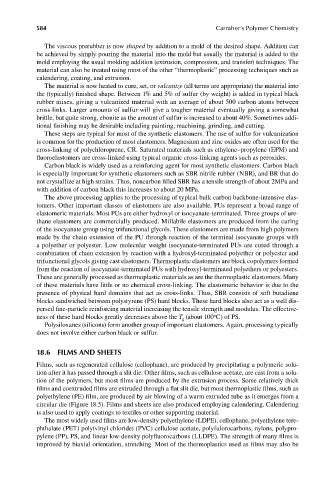Page 621 - Carrahers_Polymer_Chemistry,_Eighth_Edition
P. 621
584 Carraher’s Polymer Chemistry
The viscous prerubber is now shaped by addition to a mold of the desired shape. Addition can
be achieved by simply pouring the material into the mold but usually the material is added to the
mold employing the usual molding addition (extrusion, compression, and transfer) techniques. The
material can also be treated using most of the other “thermoplastic” processing techniques such as
calendering, coating, and extrusion.
The material is now heated to cure, set, or vulcanize (all terms are appropriate) the material into
the (typically) finished shape. Between 1% and 5% of sulfur (by weight) is added in typical black
rubber mixes, giving a vulcanized material with an average of about 500 carbon atoms between
cross-links. Larger amounts of sulfur will give a tougher material eventually giving a somewhat
brittle, but quite strong, ebonite as the amount of sulfur is increased to about 40%. Sometimes addi-
tional finishing may be desirable including painting, machining, grinding, and cutting.
These steps are typical for most of the synthetic elastomers. The use of sulfur for vulcanization
is common for the production of most elastomers. Magnesium and zinc oxides are often used for the
cross-linking of polychloroprene, CR. Saturated materials such as ethylene–propylene (EPM) and
fluoroelastomers are cross-linked using typical organic cross-linking agents such as peroxides.
Carbon black is widely used as a reinforcing agent for most synthetic elastomers. Carbon black
is especially important for synthetic elastomers such as SBR nitrile rubber (NBR), and BR that do
not crystallize at high strains. Thus, noncarbon filled SBR has a tensile strength of about 2MPa and
with addition of carbon black this increases to about 20 MPa.
The above processing applies to the processing of typical bulk carbon backbone-intensive elas-
tomers. Other important classes of elastomers are also available. PUs represent a broad range of
elastomeric materials. Most PUs are either hydroxyl or isocyanate-terminated. Three groups of ure-
thane elastomers are commercially produced. Millabile elastomers are produced from the curing
of the isocyanate group using trifunctional glycols. These elastomers are made from high polymers
made by the chain extension of the PU through reaction of the terminal isocyanate groups with
a polyether or polyester. Low molecular weight isocyanate-terminated PUs are cured through a
combination of chain extension by reaction with a hydroxyl-terminated polyether or polyester and
trifunctional glycols giving cast elastomers. Thermoplastic elastomers are block copolymers formed
from the reaction of isocyanate-terminated PUs with hydroxyl-terminated polyethers or polyesters.
These are generally processed as thermoplastic materials as are the thermoplastic elastomers. Many
of these materials have little or no chemical cross-linking. The elastomeric behavior is due to the
presence of physical hard domains that act as cross-links. Thus, SBR consists of soft butadiene
blocks sandwiched between polystyrene (PS) hard blocks. These hard blocks also act as a well dis-
persed fine-particle reinforcing material increasing the tensile strength and modulus. The effective-
o
ness of these hard blocks greatly decreases above the T (about 100 C) of PS.
g
Polysiloxanes (silicons) form another group of important elastomers. Again, processing typically
does not involve either carbon black or sulfur.
18.6 FILMS AND SHEETS
Films, such as regenerated cellulose (cellophane), are produced by precipitating a polymeric solu-
tion after it has passed through a slit die. Other films, such as cellulose acetate, are cast from a solu-
tion of the polymers, but most films are produced by the extrusion process. Some relatively thick
films and coextruded films are extruded through a flat slit die, but most thermoplastic films, such as
polyethylene (PE) film, are produced by air blowing of a warm extruded tube as it emerges from a
circular die (Figure 18.5). Films and sheets are also produced employing calendering. Calendering
is also used to apply coatings to textiles or other supporting material.
The most widely used films are low-density polyethylene (LDPE), cellophane, polyethylene tere-
phthalate (PET) poly(vinyl chloride) (PVC) cellulose acetate, polyfulorocarbons, nylons, polypro-
pylene (PP), PS, and linear low-density polyfluorocarbons (LLDPE). The strength of many fi lms is
improved by biaxial orientation, stretching. Most of the thermoplastics used as films may also be
9/14/2010 3:43:38 PM
K10478.indb 584
K10478.indb 584 9/14/2010 3:43:38 PM

